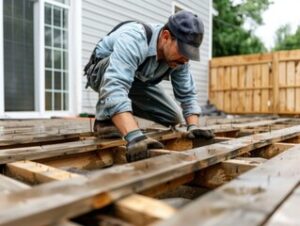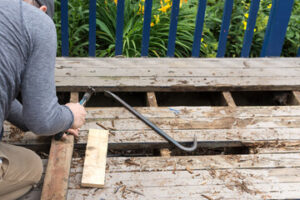Algae build-up, mold, and mildew discolor your deck and turn it into a slipping hazard if left unattended. Regular cleaning helps maintain your composite or wood deck and keep it in top shape.
Use a pressure washer at low settings and make sure to keep the nozzle at least 12 inches away to avoid damage. If you prefer a more eco-friendly cleaner, try white vinegar mixed with water or a homemade cleaning paste. Contact Charleston Deck Crafters for professional help.
1. Power Washing

Power washing is an effective way to remove stubborn dirt and grime that can be difficult to scrub off with a brush. It also helps to lift mildew, mold, or other organic stains from the surface of wood decks. However, it’s important to use a proper technique when cleaning with a power washer. If you don’t, you can damage the wood or leave behind residual cleaning chemicals that can cause further problems.
Before beginning, you should remove any furniture or other items from the deck. This will help to prevent any water or cleaning solution from getting trapped underneath them, which can lead to mildew or mold growth. You should also sweep the deck thoroughly to loosen up any dirt and debris that may be stuck to the boards. Finally, you should pre-rinse the deck with a garden hose to remove any loose dirt and help the cleaning solution penetrate the surface of the deck.
When applying the cleaning solution, it’s best to start at one end of the deck and work your way toward the house. This will help to minimize the amount of cleanup that’s required later on. It’s also important to read and follow the manufacturer’s instructions when adding the cleaner to your power washer. Make sure to use the recommended proportions and safety precautions for your specific model.
Once you’ve applied the cleaner, you can begin power washing the deck. Be sure to keep the nozzle of the power washer at a safe distance from the wood. Spraying it too close can permanently damage the surface of the deck by imprinting lines and marks into the grain. It’s also helpful to spray in long, straight strokes from one end of the deck to the other.
Once the deck is clean, it’s important to allow it to dry completely before replacing any furniture or other items. This will help to prevent any moisture from getting trapped between the deck and any objects, which can lead to mold or mildew. It’s also a good idea to re-stain the deck after it has dried, as this will help to protect it from future wear and tear.
2. Scrub Brushes
Deck scrub brushes are a versatile cleaning tool for wood floors and other surfaces. They are an essential part of any automatic floor scrubber, and they come in a variety of styles and brush materials to suit any surface and scrubbing need. It’s important to choose a scrub brush that is compatible with your machine, the type of floor it will be used on, and the kind of cleaning products you plan to use.
When scrubbing your deck, always wear rubber gloves to protect your hands from abrasions and skin irritation. It’s also important to wear protective eyewear when using power tools or any chemicals, such as sodium percarbonate. When you’re finished, be sure to rinse the deck thoroughly, and then apply oxalic acid (deck brightener) to restore the natural pH of the wood. This process will also remove any residual cleaner and help prepare the surface for a new coat of stain.
A good deck cleaner will remove most mildew, dirt, and stains from your timber decking. It’s important to pre-rinse the surface before using a deck cleaner, as this will help soften dried cellulose fibres and make them more easily dispersed. After the deck is clean, it’s important to allow it to dry thoroughly before applying a waterproof stain for protection.
For those with stubborn stains, a deck scrub brush can be a powerful cleaning solution. You can buy a deck scrub brush from your local hardware store, and it will typically have synthetic bristles that are safe to use on timber. Look for a brush that has bristles no longer than 2 inches long to avoid damaging the timber.
To use a deck scrub brush, simply add your desired deck cleaner to a bucket and mix with water. Then, dip your scrub brush into the solution and begin to brush away any caked-on stains. Scrub in a circular motion, following the grain of the deck boards. Be sure to pay close attention to any areas where stains are most prevalent, such as underneath flower pots, around BBQ grills, or near patio furniture.
3. Baking Soda
For those who prefer a more natural approach to deck cleaning, baking soda is an effective and non-toxic alternative. Before cleaning, however, make sure that the deck is free of any rugs, plants and metal items. Leaving these items on the deck during a cleaning can damage or contaminate them with chemical solutions.
Baking soda absorbs and eliminates a wide variety of unwanted odors. It also helps remove many common stains from wood, including grease, oil, mildew and wine. It is also a natural deodorizer, making it an ideal choice for eliminating organic decay, such as the carcass of a dead squirrel or rat that has found refuge underneath your deck.
If a lingering odor persists after using a baking soda treatment, treat the area with a mixture of oxygen bleach and water. The oxygen in this solution breaks down organic material that is causing the smell and helps lift staining materials from the surface of the wood. Mix oxygen bleach in a 1:1 ratio with water per the manufacturer’s instructions and apply to the deck, scrubbed with a brush or mop, as directed.
Another effective cleaning method is to use a combination of hydrogen peroxide and baking soda. This mixture works well on organic stains and will not damage the deck materials. Mix equal parts of both substances in a spray bottle, and spray the area of the deck where you want to remove stains. Allow the mixture to sit for a few minutes, then scrub it with a brush and rinse off the deck.
Aside from removing unsightly food and drink stains, baking soda can be used to tackle a wide range of other household cleaning tasks. Its mild abrasiveness helps to cut through grease on outdoor kitchen surfaces and other hard-to-clean materials such as concrete, paving stones and masonry surfaces. It’s even effective at pulling grease and oil stains from stainless steel grill grates.
It’s a good idea to keep a box of baking soda around the house, as it has numerous uses for home and garden care. While it’s theoretically good indefinitely, it can lose its potency over time and should be replaced when needed.
4. Vinegar
If you’re looking for a natural cleaner that will tackle green slime and mildew on your deck, vinegar is the way to go. This remarkable natural cleaner is a powerful disinfectant, and it works well on both wood and composite decks. Vinegar’s acetic acid dissolves the cell membranes of algae, eliminating them and preventing their regrowth. It also kills weeds and is effective for removing grease stains from your deck, making it an all-around cleaning powerhouse.
When using vinegar to clean your deck, first apply a solution of equal parts water and white distilled vinegar. If your deck is heavily infested with algae, you may need to use a more concentrated solution of undiluted vinegar, but be sure to follow the manufacturer’s instructions for your specific product. Once you have the solution, apply it evenly across your deck surface, focusing on nooks and crannies where algae tend to hide. Allow the solution to sit for 15 to 30 minutes to ensure a thorough treatment.
Once the deck has soaked, rinse thoroughly with a garden hose or power washer to remove any leftover cleaner and dirt. If you are still battling stubborn stains, try a mixture of vinegar and baking soda. This will lift any remaining stains and make your deck look like new again.
If your deck is made from composite material, be sure to use a special cleaner formulated for this type of material. Many of these products are no-rinse and can be brushed or sprayed on, but be sure to read the label carefully. For an even quicker approach, mix a wood cleaner or deck cleaner with water and spray it on your deck. This method is most effective on dry, sunny days to avoid quick evaporation.
Always wear gloves when working with any cleaning agents. Some, like Borax, can irritate the skin. Be sure to dispose of any leftover cleaning solutions in a safe place and keep them out of reach of children. By following these tips, you can clean your deck quickly and easily with products that are better for the environment, as well as your home.
